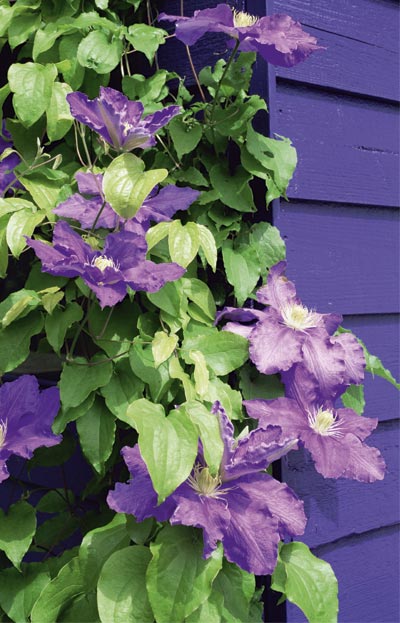It’s not always easy to grow, but glorious clematis is worth the effort
**Clematis: the 3 groups
**These gorgeous flowering climbers are a diverse range of plants, but clematis can be broadly grouped into early-flowering, large-flowered hybrids and late-flowering types. These groups are helpful in deciding how to prune your clematis and correct pruning is a major factor in how well they flower.
**Early flowerers
**Among the early flowerers is our native puawhanganga (Clematis paniculata), which erupts in massive veils of white starry flowers throughout our native bush in early spring. ‘Bridal Veil’ has bronze markings on its leaves and ‘Purity’ is a vigorous male form with large, pure white flowers. These need a very large tree to climb!
‘Clematis Sweet Hart’ is the opposite. It grows to just 50cm, with masses of scented white flowers in early spring. ‘Black Ice’ is similar but has dark foliage. Both are great for small gardens and containers.
Probably better known in gardens is the deciduous montana group. These vigorous vines produce a mass of flowers in white and shades of pink, with a few double varieties available from connoisseur suppliers. oontanas need lots of space to develop and a very strong support.
A popular evergreen to cover large areas is Clematis armandii, which has dark-green leathery foliage and white flower clusters.
**Large Hybrids
**With flowers the size of a small saucer, these are my pick of the bunch – and also the ones I’ve managed to kill off more than once. There are scores of varieties, ranging in colour from pure white through varying shades of pink to deep burgundy and pale to velvety blue.
one of the most popular double varieties is named after opera singer Kiri Te Kanawa. oddly enough, when doubles repeat flower later in summer, they produce single flowers, not double. I much prefer the singles for their striking effect and superb simplicity. There are both early and late-flowering hybrids and most repeat flower through the season.
With careful selection of varieties, you can have clematis hybrids flowering from early spring through to late summer. Hybrids are deemed to be the trickiest clematis of all for their tendency to succumb to wilt disease. The best way to combat this is to plant them deeper than you might expect.
**Late flowerers
**Late-flowering clematis include the Jackmanii group, many of which have smaller flowers than earlier hybrids. The predominant colour range is rich purple to dark red. All hybrids grow to significant proportions if allowed, some up to 6m high. But their growth is not as dense and therefore heavy as the montana group, so they are well-suited to growing through host plants like trees or rambling roses. If the bug catches you, there are many other types of clematis too, such as hardy winter-flowering Clematis cirrhosa.
**Clematis: quick pruning guide
**Clematis is a complex group of plants, but their flowering time will help in determining how and when to prune each one. Check which group your clematis belongs to and label them as you plant so you will know when to pick up the secateurs!
Winter and once-only spring flowering clematis Do not prune unless:
Plant size needs to be restricted (trim stems to 1m high in winter).
Plants are old and tangled (thin out weak or dead stems).
Restorative pruning is required (if so, prune to ground level leaving a few young, healthy shoots).
**Early repeat-flowering hybrids
**Prune lightly in late winter by removing oldest weakest stems leaving six to 10 strong stems. Shorten remaining stems to 1.5m to 2m, trimming back to strong buds.
**Late repeat-flowering hybrids
**Prune hard in late winter to about 30cm high, trimming back each stem to its strongest buds. Make your cuts higher where plants need to reach a host such as a tree or pillar.
How to grow healthy clematis Clematis require:
Constantly moist, well-composted and well-drained soil.
A cool root run.
To be able to grow into the sun.
Prevent wilt disease by:
Planting evergreen clematis 5cm deeper than the top of the root ball.
Planting hybrid clematis 15cm deeper than top of the root ball.
Buds below soil level generally survive wilt disease and will sprout if growth above ground dies back.
**When planting:
**1. Mix well-rotted manure or blood-and-bone into the soil in the base of the planting hole. 2. Put clematis in hole still in its container. 3. Slit container and gently remove plant without disturbing roots. 4. Back-fill the hole with a mix of fresh compost and soil. 5. Lead shoots to their host plant or climbing frame and tie loosely. 6. Water and mulch well with granulated bark or compost. 7. Feed with slow release fertiliser in early spring and mulch annually.




